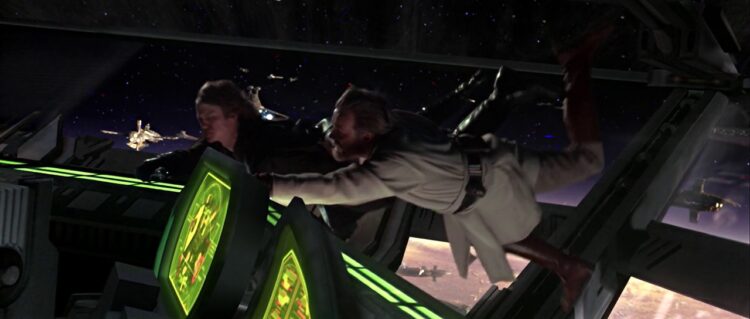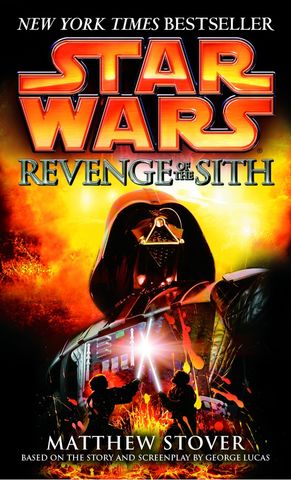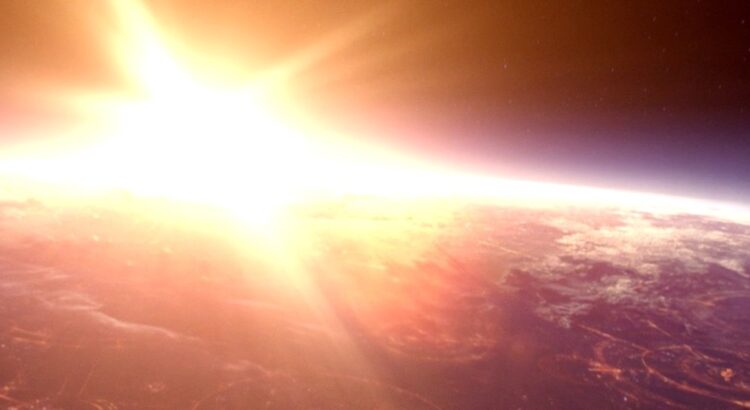It is commonly believed that the Revenge of the Sith novelization is a better telling of that story than the very movie it was meant to adapt. It has richer dialogue, the motivations of every character are beautifully displayed, and the overall plan to seduce Anakin to the dark side and take over democracy and the galaxy itself is made extremely clear. All of it told in the masterful writing of Matthew Stover, which makes it not only one of the best Star Wars novels produced, but also a great novel in its own right. And given that I start this post with so much praise for this book, it may come as no surprise that it also treats physics in a better and more consistent way than the film.
The spectacular opening of the movie puts us in the middle of an unprecedented engagement, with hundreds of capital ships in combat and many more starfighters threading the space between them. The visual look is also unlike in any previous Star Wars installment, with the light of the sun coming very low and filtered through the planet’s atmosphere, making it feel like the battle is fought at dusk or dawn, and with fire and smoke surrounding many of the cruisers. Such a distinct style was achieved by setting the scene in a unique environment, as John Knoll explains in the DVD audio commentary:
“One of the things that makes this space battle different than the other Star Wars pictures is that…we’re saying this is not in space exactly. We’re in the upper atmosphere of Coruscant, which gives us excuses to do things like drag. You’ll see there’s smoky trails behind burning ships. There’s bits of atmosphere hanging smoke.”
So this “space battle” is really an aerial battle, and contains many elements that would go against physics in a deep space setting.[1]Not long after, The Clone Wars seemed to point at this and say “That’s the Star Wars visual look for explosions in space from now on, deal with it”, but that’s a whole other … Continue reading But given the visual spectacle it was meant to be, and the many factors in play that a novel is not beholden to, it is likely for such a movie to present some internal contradictions. Since physics is my field of expertise, in this piece I will discuss one such inconsistency that is hard to explain away as compared to the novel, which has far fewer limitations in depicting how those events might have actually taken place. While fans tend to see the live-action version of a story as taking absolute precedence over any other interpretation, I would postulate that this is not always the case.
The opening battle of Revenge of the Sith provides a good illustration of a misconception that’s also prevalent in many other space movies: being “in space” and being “in orbit” are not the same thing. Especially close to a planet. What we must first understand is that, when in orbit, an object is constantly falling. The only thing preventing it from hitting the planet’s surface is a very high horizontal speed, so that by the time gravity has bent the trajectory downwards, the object has moved so far that it overshoots the round shape of the planetary body and just keeps circling around it. If said object is closer to the planet it will feel a higher gravity, so it’ll have to move faster to remain in orbit instead of crashing. And in the absence of drag all objects fall at the same rate, so if you have a bunch of them following the same orbit (say, a spaceship with some crewmembers inside), they’ll all move at the same speed and accelerate at the same rate, so they’ll feel like they’re floating with respect to each other. That’s where weightlessness comes from when in orbit: not the absence of gravity itself, but the fact that all neighboring objects are falling together. Gravity is definitely still present in space, and in low orbit it’s nearly as great as on the planet’s surface (90% as strong at the altitude of the International Space Station, for example).

When the movie starts, almost everything we see matches the explanation given by Knoll. Smoke from fires and explosions stays in the air or rises up slowly, indicating that ships are not moving at the several kilometers per second that orbital speeds would entail, and instead are hovering over the planet with repulsor technology or something to that effect. The ARC-170 starfighters maneuver with flaps and ailerons, which would only work in air. During the buzz droid attack, the gases, sparks and debris flung out as they work to disable Obi-Wan’s fighter all get dragged backwards by the air resistance, causing the cockpit to fog. Even R2’s counterattack with electricity indicates the presence of air, since the “lightning” we see in these types of discharges is caused by atoms in the atmosphere re-emitting energy they gained when electrons in the current bumped into them. Electric arcs and streamer discharges like these are not something you can just shoot in a desired direction, but the messy path that charges follow when dense air impedes a more straight route between two points with different voltage. And this also tells us that, certain visual indicators notwithstanding, we can’t be many tens of kilometers up in the atmosphere, since the lower pressure up there would make lightning look very different.
Up until now, only a few details are inconsistent with Knoll’s comments. When defeated, the buzz droid’s legs stop supporting its weight and, since we’re not in orbit, it falls on the fighter’s wing as we would expect. Then it gets dragged backward by air resistance, leaves the fighter’s surface…and instead of continuing the fall, it starts levitating. And this is not the only instance: there’s a shot focused of an ARC-170 exploding where all the pieces end up suspended in the air too, and even the burning hull of half a capital ship can be seen floating in the background.
But as the sequence continues, the atmospheric interpretation is still mainly right. Grievous’s capital ship suffers extensive damage and, perhaps with some repulsorlifts disabled, it immediately starts falling toward the planet. If the ship was in orbit, it would be in free fall already and inertia would’ve kept it going forward instead. And of course, artificial gravity would be needed to keep things on floors instead of floating around. However, with the ship just hovering above the surface of Coruscant, the gravity felt inside could be that of the planet itself. So when its nose starts dipping toward the surface, many objects start falling toward the forward bulkheads, and even the protagonists start walking on them as the floors become vertical walls.
Things start to change during the fight with Grievous, though. Now we see him tell droids to “keep the ship in orbit”, and his escape is facilitated by a difference in air pressure so great that it nearly sucks them all out of the bridge when he destroys a window—yet such a difference is belied by the raging capital ship fires nearby.

Later, the capital ship starts falling toward the planet at such high velocity that extended flaps and drag fins cause the enveloping air to glow, ionized and turned into plasma while the ship breaks up and falls apart. The effects are probably inspired by the loss of Space Shuttle Columbia in 2003, and visually spectacular, but there is a problem: the speed needed to compress and ionize the air to such a degree is not what the ship would experience if dropped from high up inside the atmosphere. This happens when an object encounters the air at orbital speeds (even in the thin, upper atmosphere), and we actually see in the movie that the direction of travel is mostly horizontal, rather than vertical. Yet Obi-Wan even announces “We’re in the atmosphere” later on, contradicting the previous visuals.
So, what happened? In the Making of and Art of books for the film, we can see that the sequence was referred to as both “aerial battle” and “space battle”, alternating back and forth, so it’s possible that there was a mix of concepts and ideas. Some scenes demanded the action to be set in space while the visual look required an atmosphere, and some others needed gravity to point always at the planet as the ship changed orientation, while the crash was planned as a fall from orbit.
Since visual spectacle is not the main priority in a novel, these inconsistencies are solved there by placing the battle explicitly in orbit, outside the atmosphere. The loss of visibility Obi-Wan suffers from the buzz droid attack happens because the cloud of gas released stays with the fighter unless he accelerates away; R2 attacks the droid not with electricity, but with a saw of his own; and once disabled, the buzz droid is not dragged away by air but kicked by R2 himself into the engine wash of the fighter, which pushes it backward. Obi-Wan’s criticism of Anakin for not having taken the hangar shield down becomes a more urgent plea, as his fighter in the novel has lost all control and momentum was carrying him forward on a collision course (he even manages to trigger a full reverse command with the Force which slows him somewhat, and surrounding pieces of debris are described as moving forward with their original speed and impacting the still-active shield). And of course, now the pressure difference is so great that the sudden expansion of the air in the hangar cools it down to such a degree that frost appears in Obi-Wan’s beard. In this scenario, the changes in the orientation of gravity inside Grievous’ ship are caused by the battle damage desynchronizing the artificial gravity generators.

As I said above, I like the novelization more than the movie for this and many other reasons, but it’s fun to imagine what a more realistic version of the aerial battle would’ve looked like, because they really were close to getting the physics right for that scenario.[2]And the inconsistencies make for interesting discussions that can be used to teach physics in blog posts like these, but the educational impact of an accurate depiction in the movie could’ve … Continue reading Removing the orbital reentry might result in a visually duller ending, or perhaps could provide an equally exciting sequence where Anakin needs to use maneuvering flaps and hatches to turn a vertical drop into a survivable glide, while avoiding too much collateral damage.
But at the end of the day, and despite their differences, movie and novelization are not meant to substitute each other. Stover himself has said that the novel is intended as a companion piece to the film, letting each medium excel at what it does best: the movie takes care of the striking visuals, while the novel gives insight on the psychology of the characters at a level the movie is not suited for, and uses the opportunity to show the things they hide from each other or even themselves. Furthermore, he thinks of the novel as “adapted from the screenplay” rather than “based on the film”, as it had to be finished many months before the movie’s release, preventing a one-to-one correspondence anyway. Lucas also gave him the freedom to alter dialogue, and to expand some scenes or better transmit the meanings a movie might convey with the actors’ delivery of certain lines, and the final revision of the text included a line-by-line edit by the man himself. If for him both versions were valid and played to the strengths of each medium, then the movie could also be considered an adaptation of some “actual” version of events that you’re free to interpret as long as the main beats stay the same.
This approach also seems to be the way all continuity is handled in Star Wars since the reboot took place, and it might be worth extra consideration now that live-action content is again a big driver of storytelling. VFX teams at Industrial Light and Magic are usually quite good with physics, but as I’ve discussed, this medium has inherent limitations. Books are generally better at handling physics consistently and providing deeper psychological insights, both of which tend to be key elements in the Thrawn novels, for example, and might not translate well to screen in his future appearances. Treating a live-action presentation as just another adaptation of the way events might have taken place could alleviate the perception of inconsistencies in the story, leaving further explorations of the issue for a medium better suited for it.
| ↑1 | Not long after, The Clone Wars seemed to point at this and say “That’s the Star Wars visual look for explosions in space from now on, deal with it”, but that’s a whole other story. |
|---|---|
| ↑2 | And the inconsistencies make for interesting discussions that can be used to teach physics in blog posts like these, but the educational impact of an accurate depiction in the movie could’ve been wider! |

